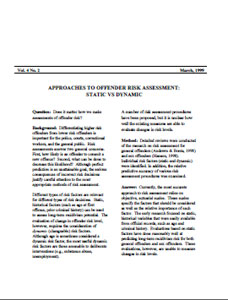Approaches to offender risk assessment: static vs dynamic
Research summary
Vol. 4 No. 2
March 1999
Question
Does it matter how we make assessments of offender risk?
Background
Differentiating higher risk offenders from lower risk offenders is important for the police, courts, correctional workers, and the general public. Risk assessments answer two general concerns. First, how likely is an offender to commit a new offence? Second, what can be done to decrease this likelihood? Although perfect prediction is an unattainable goal, the serious consequences of incorrect risk decisions justify careful attention to the most appropriate methods of risk assessment.
Different types of risk factors are relevant for different types of risk decisions. Static, historical factors (such as age at first offence, prior criminal history) can be used to assess long-term recidivism potential. The evaluation of change in offender risk level, however, requires the consideration of dynamic (changeable) risk factors. Although age is sometimes considered a dynamic risk factor, the most useful dynamic risk factors are those amenable to deliberate interventions (e.g., substance abuse, unemployment).
A number of risk assessment procedures have been proposed, but it is unclear how well the existing measures are able to evaluate changes in risk levels.
Method
Detailed reviews were conducted of the research on risk assessment for general offenders (Andrews & Bonta, 1998) and sex offenders (Hanson, 1998). Individual risk factors (static and dynamic) were identified. In addition, the relative predictive accuracy of various risk assessment procedures was examined.
Answer
Currently, the most accurate approach to risk assessment relies on objective, actuarial scales. These scales specify the factors that should be considered as well as the relative importance of each factor. The early research focused on static, historical variables that were easily available from official records, such as age and criminal history. Evaluations based on static factors have done reasonably well at predicting long-term recidivism risk for both general offenders and sex offenders. These evaluations, however, are unable to measure changes in risk levels.
During the past 20 years, researchers have identified a number of dynamic risk factors for general recidivism (e.g., antisocial peers, procriminal attitudes) and these dynamic factors have been organised into validated, actuarial risk scales. Overall, dynamic factors appear to have as much predictive accuracy as static risk factors. The research on sex offenders has only recently considered dynamic factors, and dynamic factors have yet to be incorporated into sexual recidivism risk scales.
Policy implications
- Knowledge about static risk factors is sufficiently well developed that scales based on these factors can provide meaningful assessments of offenders' long-term risk potential.
- For most contexts, evaluators would want to consider both static and dynamic factors. For example, an assessment of high risk by a static risk scale may suggest the need for incarceration. However, without a dynamic risk assessment there is little information as to when the offender can be safely released.
- Knowledge of dynamic risk factors is required to effectively treat and supervise offenders. Intervention efforts should focus on those characteristics (i.e., dynamic risk factors) most strongly related to criminal behaviour.
Source
- Andrews, D. A., & Bonta, J. (1998). The Psychology of Criminal Conduct (2nd ed.). Cincinnati, OH: Anderson.
- Hanson, R. K. (1998). What do we know about sex offender risk assessment? Psychology, Public Policy, and Law, 4, 50-72.
For further information
James Bonta, Ph.D.
Solicitor General Canada
340 Laurier Avenue West
Ottawa, Ontario
K1A 0P8
Tel (613) 991-2831
Fax (613) 990-8295
e-mail jim.bonta@ps-sp.gc.ca
- Date modified:
